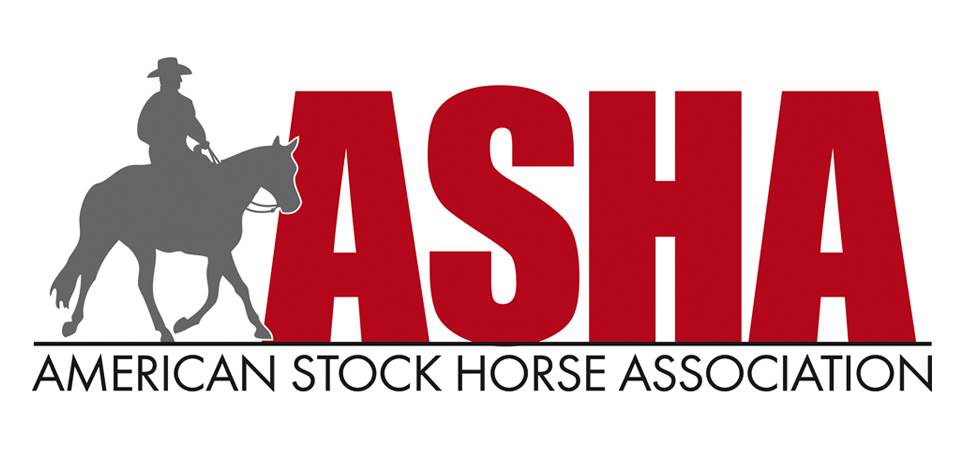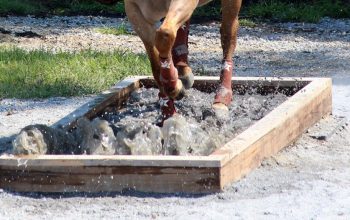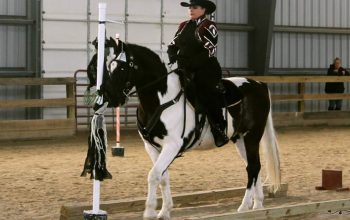 Are you looking for something fun, friendly and exciting to experience with your horse? You may be an entry-level rider, someone who has ridden your entire life, or a professional in the horse industry looking to to improve. The American Stock Horse Association is dedicated to preserving western traditions and offers an atmosphere that is not typical of horse shows. The Board of Directors are devoted to creating a venue that is out of the horse show box.
Are you looking for something fun, friendly and exciting to experience with your horse? You may be an entry-level rider, someone who has ridden your entire life, or a professional in the horse industry looking to to improve. The American Stock Horse Association is dedicated to preserving western traditions and offers an atmosphere that is not typical of horse shows. The Board of Directors are devoted to creating a venue that is out of the horse show box.
WHAT IS ASHA?
ASHA is an International Horse Association, with affiliates in North America and Europe, that takes great CARE in their membership.
C – Clinics At Each Event
A – All Breeds are Welcome
R – Rewarding through Positive Scoring System
E – Educational
The versatility based show concept promotes the Stock Horse. You may be asking yourself what is a stock horse? ASHA defines the stock horse as a working and usable horse designed and trained to perform a job. This horse is a jack of all trades and is not limited to one breed. ASHA is open to ALL breeds, including mules, gated horses and ponies.
The Versatile Stock Horse Concept is an All-Around horse format that puts an emphasis on competing in all four classes vs other show formats that just focus on one single class. An ASHA hero horse is consistent, agreeable and uses its natural abilities when competing in all four classes.
This format opens the door to many participants with diverse backgrounds i.e. entry level exhibitors that have never shown, pleasure and trail riders, and those who have competed competitively in reining and cow horse events. Each of these different competitors can come show, while one discipline does not have an advantage over another.
 To promote versatility, ASHA stands behind their Mission to “Help People Ride A Better Horse”, through clinics at each event. This in part drives ASHA’s dedication to enhancing the pleasure of owning and riding horses through creating better horses and horsemen.
To promote versatility, ASHA stands behind their Mission to “Help People Ride A Better Horse”, through clinics at each event. This in part drives ASHA’s dedication to enhancing the pleasure of owning and riding horses through creating better horses and horsemen.
ASHA Conviction – that any age horse can be ridden in a snaffle bit, hackamore or bit. This rule is very unique and beneficial in achieving the ASHA Mission. Education and Clinics creates a supportive learning environment, in addition to our respectfully competitive shows. Overall the event is focused on improving each participants horsemanship skills. With multiple local clinicians working together during the event, the Clinician Team helps to demonstrate and promote ASHA’s philosophy and rules. With more than one clinician, the exhibitor will be exposed to different techniques and teaching styles. This gives the participant the option to pick and choose what fits them and their horse.
Through the clinics, participants build camaraderie and friendship with the clinicians and other exhibitors. This raises each riders comfort level and eliminates the stigma of horse shows. Learning in a fun and supportive environment creates a platform for exhibitors to have a strong foundation in the rules, training practices, how to get a horse shown, exposure to information that judges are being taught, and in seeing it through the judges eyes. This brings back a level of social camaraderie that has disappeared from horse shows, and with this comes fun and enjoyment.
 Affordability is encouraged by ASHA to show producers and affiliates. Keeping clinics and show fees affordable is an opportunity to bring the entire family to show.
Affordability is encouraged by ASHA to show producers and affiliates. Keeping clinics and show fees affordable is an opportunity to bring the entire family to show.
Four Classes listed below are offered by ASHA and act as a leveling agent for exhibitors:
Stock Horse Pleasure is the cornerstone class of ASHA and has distinct differences from other associations. First, this class runs one horse at a time with signs in the arena to represent the vicinity of where the transition should take place. This is not an equitation class. Simply, the horse is being judged on how it moves. Judges are encouraged to credit forward motion, and will pick the horse that they would want to ride to check 5 miles of fence line. This will be a horse that is well-broke, relaxed, quiet, and has smooth transitions.
Stock Horse Trail class measures the horse’s ability to handle everyday situations and encounters. Obstacles are natural and what you would see in an everyday ranch environment. The pattern is intended to be simple and straight forward, not to scare or confuse horse and rider. There is plenty of content to judge without adding artificial tricks or movements to the class.
 Stock Horse Reining class measures the ability of the stock horse to perform many basic handling or usable maneuvers, while being willfully guided. Reining maneuvers such as stopping on the haunches, correct spin, controlled and deliberate back up, snappy over the hock roll backs, and nice circles. Smoothness, willingness, and correctness demonstrate the horse’s ability to complete the pattern.
Stock Horse Reining class measures the ability of the stock horse to perform many basic handling or usable maneuvers, while being willfully guided. Reining maneuvers such as stopping on the haunches, correct spin, controlled and deliberate back up, snappy over the hock roll backs, and nice circles. Smoothness, willingness, and correctness demonstrate the horse’s ability to complete the pattern.
Stock Horse Working Cow Horse classes are designed to demonstrate and measure the horse’s ability to work a cow. Three levels are offered and listed below.
Novice and Youth Working Cow Horse Class was developed as an entry-level cow class and consists of a warm up dry work pattern and boxing for one minute. The dry work simulates the same moves that the horse will do while controlling the cow. This is not an equitation pattern and the judge wants to see you make maneuvers as if working a cow.
Green Horse and Limited Non-Pro Working Cow Horse Class has no dry work prior to working the cow and is developed as an intermediate level cow horse class. Horse and rider will box the cow, drive the cow down the fence and then box the cow at the opposite end of the arena. The horse demonstrates control of the cow for two minutes. This class is a stepping stone up or down for exhibitors. Novice riders can expand their boxing skills by building confidence from boxing and controlling the cow at the opposite end of the arena, without the fast paced fence turn found in the full cow horse pattern.
Exhibitors that have competed in the full cow horse class may have a new horse or reach an age that they are unable to compete in the full cow horse pattern. This class gives them a place to step back and build confidence with their horse.
Open and Non-Pro Working Cow Horse Class is the full pattern where the horse boxes the cow, completes fence turns in each direction, and then the rider makes the decision whether they want to circle the cow each way once or rope and stop the cow. During this class the rider has three minutes to complete the required maneuvers, but it may be completed in less time.
ASHA Judging is very unique to the horse industry. Scoring is based on a positive scale, with a score of 1-10 given for each maneuver. A maneuver score of 6-7 is considered correct, and the scores will go up and down from there. Credits and deductions are used to adjust the score, based on the content and quality of the maneuver. ASHA maintains a comment box instead of a penalty box, including a translation key on the scorecard that communicates to the exhibitor deductions and also credits. This helps the participant decipher their scores for each maneuver.
 Scoring is positive and straight forward, which will encourage growth and improvement while enhancing the experience for the exhibitor. Maneuver scores give the rider a truer benchmark for their skill sets. And the most news is that there is only three ways to receive a zero score for a class: lameness, illegal equipment and disrespectful and/or abusive behavior. Please note that riding two hands on a curb bit is not a zero score, but a two point deduction per occurrence.
Scoring is positive and straight forward, which will encourage growth and improvement while enhancing the experience for the exhibitor. Maneuver scores give the rider a truer benchmark for their skill sets. And the most news is that there is only three ways to receive a zero score for a class: lameness, illegal equipment and disrespectful and/or abusive behavior. Please note that riding two hands on a curb bit is not a zero score, but a two point deduction per occurrence.
If the horse and rider make an attempt at a maneuver, they will get a score. If they forget, add in or bypass a maneuver then they will receive a zero score for that particular maneuver only. For example, if the rider completes five spins in a reining class when the pattern calls for four spins, a two point deduction will be assessed for that maneuver. The exhibitor will still receive a score and is eligible to place.
ASHA’s objective is to give you credit for what you can do and not penalize you for what you can not do. Class score sheets are posted at the show for the exhibitor to look at and track their improvement. The score sheets are a huge part of how ASHA facilitates their mission to help their members recognize their strengths and weaknesses, to experience growth and improvement and track their performance.
 Judges Seminars and Certification is something that ASHA diligently works to ensure quality judges for ASHA events through the training and testing process. Training for show producers and affiliates are also offered.
Judges Seminars and Certification is something that ASHA diligently works to ensure quality judges for ASHA events through the training and testing process. Training for show producers and affiliates are also offered.
Awards are provided on local, regional and national levels. Show producers and affiliates offer local awards while ASHA provides regional and national awards. Regional Championship All-Around buckles are awarded along with Year End High-Point All-Arounds Regionally and Nationally. ASHA has a database that is able to track a horse and rider’s record. This offers a multitude of benefits for its members.
ASHA National Championships are held in conjunction with the National Collegiate Championships produced each year by ASHA. In 2018 the Championship Clinic and Show will be held April 19-22 in Sweetwater, Texas.
The ASHA Collegiate Program has specific goals and guidelines to promote education of horsemen in the safety, care and training of the versatile stock horse. It also enhances the education of college students interested in the versatile stock horse. Using horses as a means to teach students how to represent themselves with responsibility, character and teamwork.
Within the ASHA show format collegiate competitors can compete individually and/or as a team. Currently ASHA has a number of teams with collegiate programs competing within the ASHA show format.
Aged Events promote versatility and ensure longevity in the American Stock Horse. This program has been developed and structured specific to ASHA and are different from other Associations. Three divisions have been created: 4 year old Futurity, 5 year old Derby and 6 year old Maturity.
What makes the Futurity unique is the four year old age requirement, instead of three years old. ASHA will retain a portion of the entry fee from each year as the horse competes in all three aged divisions, and at the end a horse will be crowned ASHA Aged Event Champion.
 Seven Divisions will be offered for 2018. These divisions are based on the riders experience: Open, Non-Pro, Limited Non-Pro, Novice, Youth 14-18 and Youth 8-13. The last division offered is Green Horse and this is based on the experience of the horse. ASHA is continually updating and expanding their divisions to match specific skill sets to represent their membership.
Seven Divisions will be offered for 2018. These divisions are based on the riders experience: Open, Non-Pro, Limited Non-Pro, Novice, Youth 14-18 and Youth 8-13. The last division offered is Green Horse and this is based on the experience of the horse. ASHA is continually updating and expanding their divisions to match specific skill sets to represent their membership.
The ASHA handbook can be found when you visit www.americanstockhorse.org or you can find more information on Facebook and Instagram.




